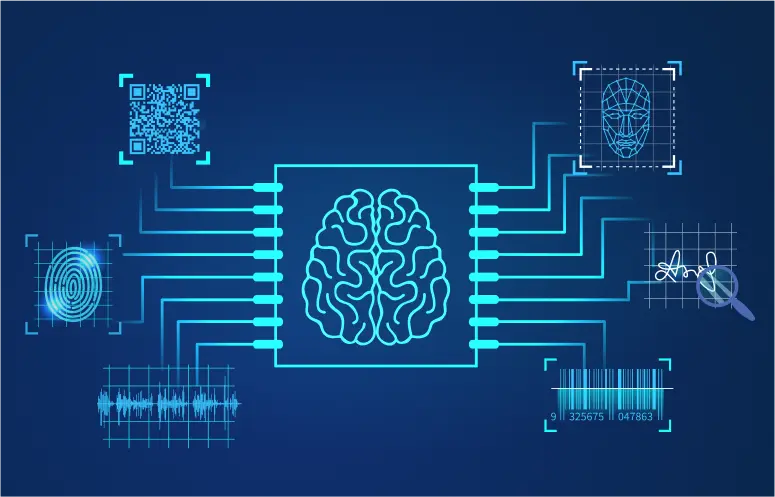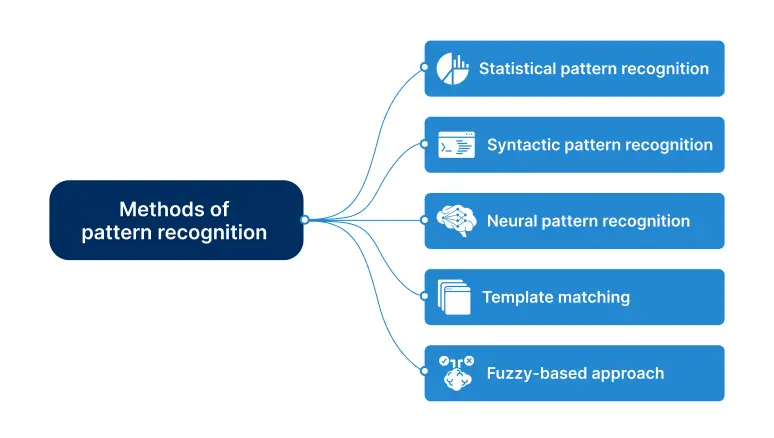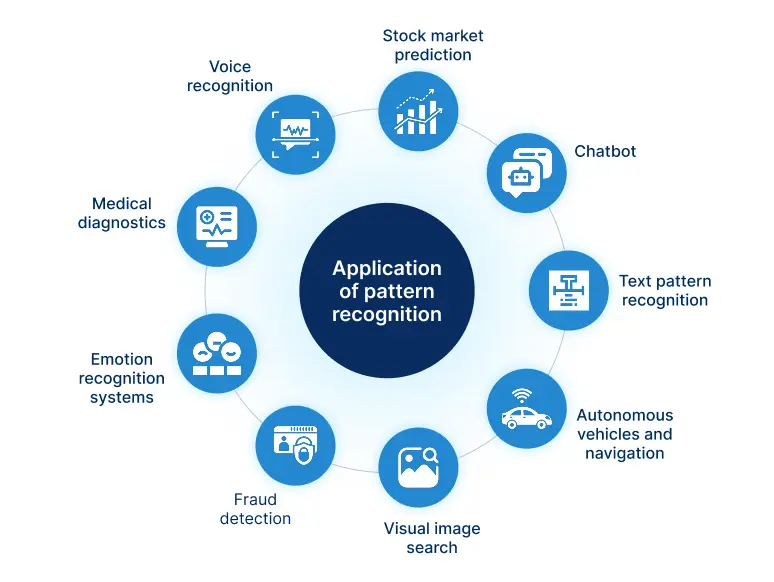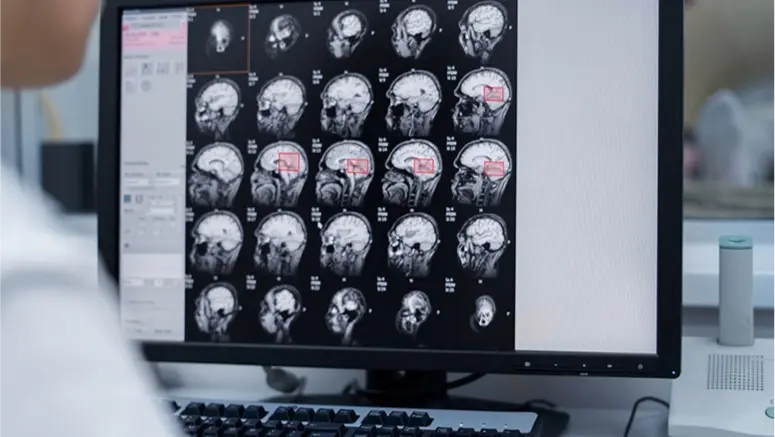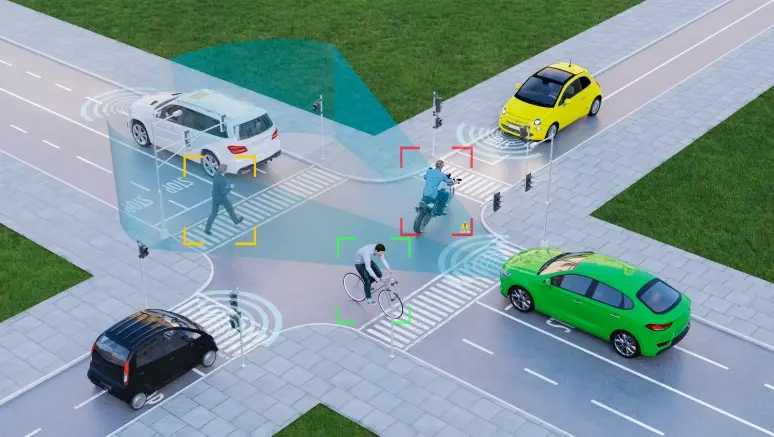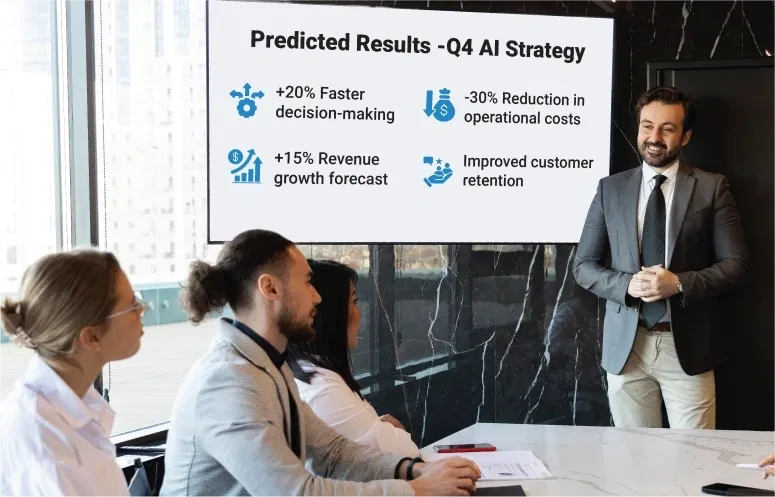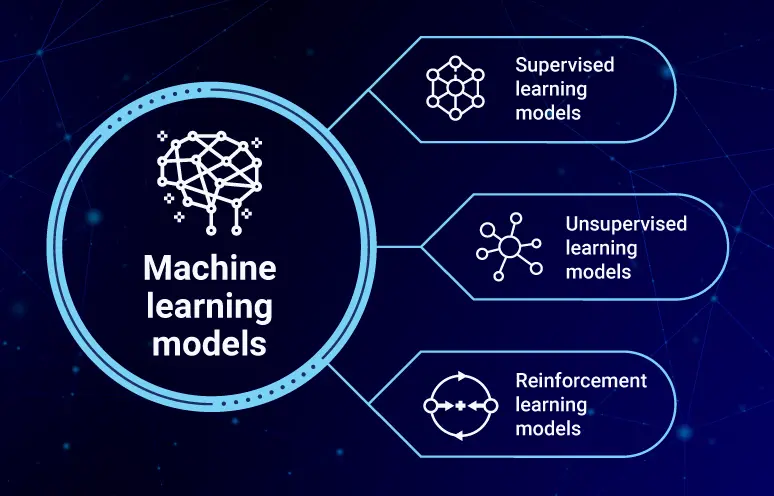Pattern recognition is a method to identify patterns and trends in data using algorithms. These patterns are further processed to make predictions and data-driven decisions. Whether it’s detecting fraudulent financial transactions, predicting customer attrition, or enabling security cameras, pattern recognition analyze behavior and trigger alerts in real time. It enables you to identify trends and relationships in data by predicting outcomes and automating the process. AI plays a vital role in automating identification of complex patterns across vast datasets, enabling faster and more accurate outcomes. With AI consulting services, organizations can use the latest algorithms and expert guidance to implement efficient pattern recognition solutions that drive innovation and competitive advantage.
In this blog post, we’ll explore what pattern recognition is, how it works, methods, benefits, challenges, and provide real-world use cases that highlight how this technology is reshaping industries.
What is pattern recognition?
Pattern recognition is a process that extracts useful insights and identifies trends to determine a pattern in the specified data set. It utilizes AI, machine learning, and computer vision to analyze large datasets and identify patterns, extract meaningful information from images and videos, and further compare the input data against the data stored to identify patterns.
Many organizations are adopting pattern recognition into their daily operations to reduce human errors and enhance reliability. For instance, a facial recognition system that has been trained using data of human faces can identify patterns in facial features and recognize a human face in new images.
How does AI use pattern recognition?
AI pattern recognition works based on statistics, data science, and computing power. Here’s how AI in pattern recognition works:
-
Data acquisition
AI models are trained on high-quality data to identify accurate patterns. Using an openly accessible dataset can streamline the process of data acquisition while maintaining strict quality checks. In a scenario where manual data collection is not possible, synthetic datasets are collected to train the AI model.
-
Pre-processing
Raw data is refined in this step to eliminate imperfections and enhance the clarity of the data needed for accurate prediction. Techniques such as smoothing and normalization are vital while modifying the image to reduce the effect of lighting variation while preparing data for further analysis.
-
Feature extraction
Input data is processed and simplified to extract the most relevant insights while eliminating the irrelevant data. This step addresses the challenge of processing high-dimensional data by ensuring the most important information is extracted and forwarded for classification.
-
Classification
Extracted features are compared with the information in the database in this step. Each feature is assigned to the most appropriate category. Classifications are done through supervised learning, where AI models have predefined pattern categories and distinguishing parameters. Parameters are decided based on input data, and the desired output is produced using the models’ pattern recognition capability.
What are the methods of pattern recognition?
Different AI models and techniques are tailored for identifying specific types of pattern recognition:
-
Statistical pattern recognition
This model relies on statistical techniques and historical data to learn features from examples by collecting and processing observations. Features are selected in a way that they don’t overlap. The machine uses the learned pattern for further processing and training. The pattern is grouped based on its features, and the number of features determines how the pattern is viewed as a point in d-dimensional space. The goal is to find relationships between variables. This approach is mainly used for prediction or classification.
-
Syntactic pattern recognition
It relies on primitives such as letters of the alphabet. It is used for recognizing complex patterns by adopting a hierarchical perspective. Syntactic pattern recognition is a subfield of pattern recognition that focuses on the rational and structural characteristics of a pattern rather than depending upon statistical features. Turning complex patterns into simpler hierarchical sub-patterns, it becomes easy to identify roads, rivers, or humans in images, or syntax and grammar in text.
-
Neural pattern recognition
It is a branch of artificial intelligence that uses neural networks to identify and interpret patterns. Neural networks function based on parallel subunits, also called neurons, that simulate human decision-making. Neural pattern recognition is the most popular form of machine learning using neural networks and deep Convolutional Neural Networks (CNN) to solve classification tasks.
-
Template matching
This technique is used to identify the similarities between two entities of the same type. Thus, template-matching models discover similarities based on a reference template in a sample. It is commonly used in digital image processing to detect small sections that match the template image. Some of the most popular application areas are quality control in manufacturing, medical image processing, facial recognition, and robot navigation.
-
Fuzzy-based approach
This approach uses fuzzy logic principles that describe patterns with fuzzy sets rather than crisp sets. A fuzzy-based approach defines fuzzy sets for features, designs fuzzy rules, and uses speculations to classify data. It is beneficial when the difference between the patterns is unclear. This technique is applied in areas where data is ambiguous, such as control systems and medical diagnosis.
4 Machine learning techniques for pattern recognition
Supervised learning
AI models are trained on labeled data, and predictions are made by comparing the input data and the labeled data. Supervised learning uses historical data to predict the outcome. Banks identify transactions as fraudulent or legitimate by analyzing historical data and identifying patterns in the transactions.
Unsupervised learning
Unlabeled data are used in unsupervised learning that uses patterns and structures to detect anomalies by discovering hidden patterns and structures. Unsupervised learning is used in platforms like cybersecurity to identify unusual login patterns even if there is no history of fraud detection.
Semi-supervised Learning
This approach uses a small portion of labeled data and mainly uses unlabeled data to produce output that balances between model accuracy and manual effort. In the healthcare industry, there are only a few scans that are labeled by experts; thus, semi-supervised learning uses both labeled and unlabeled cases to enhance disease classification.
Deep learning and neural networks
AI models used convolutional and recurrent neural networks to learn complex and high-level features from raw data. These models are used to identify patterns in images, speech, and text. Deep learning models identify minute defects on the surface of the manufacturing parts by analyzing raw image data.
What are the major business benefits of AI pattern recognition?
Pattern recognition uses artificial intelligence to analyze and find patterns to predict future trends and trigger early warning signs based on a specific pattern. It provides numerous benefits depending on its application. Some of the important benefits are:
-
High accuracy in object detection
AI pattern recognition identifies objects and hazardous events from a distance and at different angles with precision outperforming manual inspection. It is used in images and videos to identify facial patterns and conduct movement analysis. For example, in manufacturing, it minimizes the risk of defective products reaching the customer, reducing inspection time and human error.
-
Large-scale data processing
An AI algorithm in pattern recognition analyzes huge structured and unstructured data to produce relevant output in real-time, which can be impractical with traditional methods. Financial and legal firms can process massive transactions and lengthy legal documents using a pattern recognition tool.
-
Cost reduction
AI automates tasks that were previously performed by humans, reducing costs. Pattern recognition identifies anomalies in the initial stage and optimizes resources that reduce waste overheads. It fastens the process and provides more accurate outcomes with little human intervention.
-
Adaptability across domains
Pattern recognition automatically learns from complex data regardless of the domain and industry. From identifying anomalies in finance and manufacturing to learning language patterns in NLP, they adjust to the given environment, making them highly adaptable across industries.
4 Common challenges and solutions of AI in pattern recognition
While pattern recognition in artificial intelligence offers immense benefits, it also comes with a set of challenges that you need to be aware of. Let’s explore:
-
High computational demands
Challenge: Training AI models for pattern recognition requires processing power, memory, computational resources, and specialized hardware. Thus, increasing infrastructure cost and energy consumption.
Solution: Using a cloud-based platform for AI workloads can address the computational challenge. Implementing optimization techniques such as pruning and quantization reduces resource wastage.
-
Data privacy concerns
Challenge: Pattern recognition system uses sensitive and personal data such as voice recordings or facial images to analyze behavior patterns, raising data privacy and security issues.
Solution: Adopting a data anonymization technique and implementing privacy-protecting machine learning methods like federated learning ensures data privacy and compliance. Moreover, implementing strong encryption, access controls, and regular audits can enhance data privacy.
-
Data quality
Challenge: Pattern recognition works well when the data provided is accurate and high-quality. If the data is incomplete, biased, or unrepresentative, it can result in poor accuracy and skewed predictions.
Solution: Ensure the quality of data is good and representative by implementing data cleaning, processing, and validation techniques. Conducting regular audits and using synthetic and open-source data can enhance the quality of data.
-
Model transparency
Challenge: Deep neural networks operate as “black boxes,” making the decision-making process complex and raising ethical concerns.
Solution: Implementing techniques that make model behaviour more interpretable without compromising on the quality, enabling transparency and adherence to regulatory compliance.
9 Examples of pattern recognition
Pattern recognition system is used in various industries and is an incredibly versatile practice. Here are some of the most common applications across industries.
-
Fraud detection
Financial organizations use pattern recognition to find anomalies in transactions that identify suspicious behavior. This technique is used in industries such as finance, banking, and e-commerce. For instance, a sudden high volume of transactions from a particular location can be identified by a pattern recognition system and trigger an alert of suspicious activity.
-
Medical diagnostics
This technique is applied in medical imaging to identify tumors and analyze medical scans such as X-rays, MRI, and CT scans. Clinical Decision Support Systems (CDSS) are useful in diagnosing patients based on their visual symptoms, and Computer-Aided Detection Systems (CAD) use algorithms to assist doctors when predicting medical images.
-
Voice recognition
Pattern recognition is used to identify patterns in speech. This system is commonly applied in car navigation systems and voice search engines to understand and respond effectively to customer requests. Speech recognition techniques allow people with visual impairments to hear and send back the text.
-
Stock market prediction
Deep learning models are used in predicting future stock values. Traders use stock price charts and chat patterns to identify future price movements and take data-driven decisions. For instance, a trader uses charting software to observe a head and shoulders pattern, characterized by a peak (head) between two lower peaks (shoulders), as a potential bearish reversal signal.
-
Chatbot
Machine learning algorithms are used by chatbots to classify text based on the pattern of the sentence and produce effective results. AI model identifies all possible patterns to respond to user input. Chatbots use machine learning and natural language processing systems to interpret user intents and generate appropriate responses. It uses pattern recognition to analyze customer queries, helps patients in preliminary symptom analysis, and screens resumes by recognizing patterns in applicant qualifications and experience.
-
Emotion recognition systems
Machine learning in pattern recognition is used to identify human emotions by analyzing the facial expressions, voice, text, and physiological signals. The goal is to indicate the mood, opinion, and intent of an audience or customers. Customer support services use Speech Emotion Recognition (SER) to identify customer emotion and provide agents with real-time feedback for faster conflict resolution, reduced churn, and improved service quality.
-
Text pattern recognition
Machine learning is used to generate, analyze, and translate text, and then patterns are used to create text messages. Techniques like Optical Character Recognition are used to text recognition of words to classify documents and detect sensitive text passages automatically. For instance, retailers can analyze customer feedback to proactively address issues, prioritize product improvements based on customer demand, and enhance overall customer experience.
-
Autonomous vehicles and navigation
Self-driving car uses pattern recognition in visuals and sensor data to identify objects, road signs, and lane boundaries. This proactive analysis allows vehicles to make real-time decisions for safe navigation. For example, Tesla uses computer vision and sensors to navigate roads, maintain proper lanes while driving, and avoid obstacles, ensuring safer and more efficient driving without human intervention.
-
Visual image search
Pattern recognition is used in visual image search, allowing AI models to process and interpret visual information to find relevant images based on visual features. E-commerce platforms use pattern recognition in visual search to allow customers to select products by uploading images, making product discovery easier and more intuitive.
Key tools used for pattern recognition
Numerous tools are used to develop pattern recognition and machine learning models depending upon different data types, complexities, and integration needs.
-
IBM Watson studio
It’s an open-source tool by IBM for building and deploying machine learning models on a desktop.
-
Microsoft azure machine learning studio
Provides a graphical user interface that user can use to drag and drop elements to create and deploy machine learning models.
-
Google Cloud AutoML
Uses reinforcement learning and neural networks as the basis to design high-quality machine learning models with minimum requirements.
Turn data into decisions with AI powered pattern recognition
AI-powered pattern recognition is reshaping how organizations analyze data, uncover insights, and make confident decisions. From streamlining operations to enhancing customer experiences, it enables businesses to innovate and gain a competitive edge. By leveraging advanced algorithms and expert guidance, you can identify hidden opportunities and drive measurable results. Partner with our AI consulting services today to harness the power of intelligent pattern recognition and accelerate your business growth.
FAQs
1. Can AI recognize patterns in real-time?
Yes, AI can recognize patterns in real time, using advanced algorithms and powerful processing capabilities. It analyzes incoming data on the spot, whether it’s video, audio, or sensor readings, to detect trends, anomalies, or specific objects instantly. This real-time pattern recognition is what powers applications like fraud detection, self-driving cars, and live surveillance systems.
2. How does AI use pattern recognition?
AI uses pattern recognition to identify trends, relationships, or repeated structures within large sets of data. It analyzes these patterns to recognize images, understand speech, predict behaviors, or even detect anomalies. By learning from past data, AI can make decisions and predictions that mimic human-like understanding but at a much faster scale.
3. What industries benefit the most from AI pattern recognition?
Industries like healthcare, e-commerce, manufacturing, finance, and transportation benefit the most from AI pattern recognition. For example, in healthcare, it helps analyze medical images to detect diseases early and improve patient outcomes. In e-commerce, it powers personalized recommendations, making shopping experiences faster and more relevant for customers.
4. How can businesses implement AI pattern recognition?
Businesses can start by identifying processes where pattern recognition can add value, like quality control, fraud detection, or customer behavior analysis. Next, they need to gather clean, high-quality data and choose the right AI tools or partner with experts to build and train models. Finally, integrating the solution into existing workflows and continuously monitoring its performance ensures it delivers accurate, actionable insights over time.
5. What is the role of deep learning in pattern recognition?
Deep learning plays a key role in pattern recognition by automatically learning complex patterns and features from raw data. Unlike traditional methods that rely on manual feature extraction, deep learning models can identify subtle and intricate patterns on their own. This makes them highly effective for applications like image recognition, speech processing, and fraud detection.
6. Which AI system can be trained to recognize patterns?
Machine learning systems, especially neural networks, are commonly trained to recognize patterns in data. These systems learn from examples, identifying relationships and trends that might not be obvious to humans. Over time, they improve their accuracy, making them useful for tasks like image recognition, speech processing, and fraud detection.
